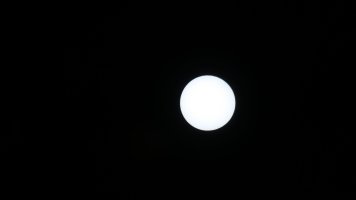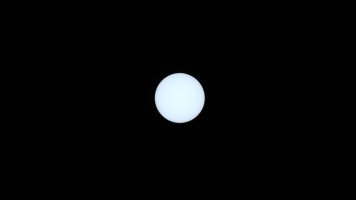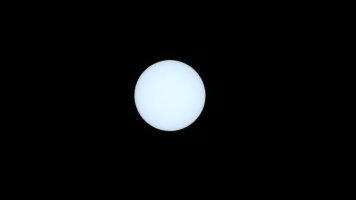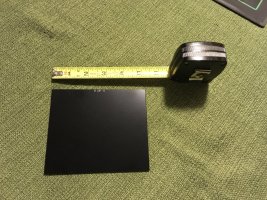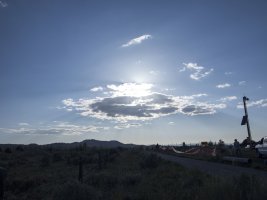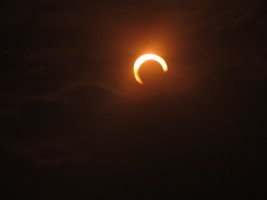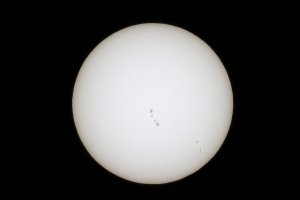I'll be going to Oregon to view the solar eclipse in August. Initially I was planning on taking 5D Mark III with 100-400L II and 1.4 & 2.0 III Extenders, G3X and G1X (IR Modified). I will need to take 3 tripods and will use a gimbal with the 5DIII and ball heads with the others. Naturally I want to take pictures of the eclipse progression and therefore need to use a filter until the sun is fully eclipsed. I will be using the Lee Big Stopper and Little Stopper stacked together and have tried this combination on both the 5DIII and G3X with full sun and it appears to work fine. I've taken test shots of the sun to get a starting point for manual settings, but will have to refine them just before the eclipse starts. I can't see any difference between the pictures of the full sun from the 5DIII and the G3X, which is probably not surprising given there's not much detail on the full sun (both showed a few sunspots, and they looked the same). If I want to use both cameras at the same time, I will have to get another filter, which is an added expense (looking at the Marumi 16.5 stop 77mm filter @USD125 @ B&H, but there's no ratings and it's special order (noncancelable and nonreturnable) - anyone used this?) I'm now wondering whether it is even worth taking the 5DIII if there's no real image quality difference between it and the G3X for this application. However, it would mean I'd be limited to 600mm rather than 800mm, but I suspect some of the corona at full eclipse may be cut off at 800mm (I'm not sure on this). I don't know if the lack of apparent image quality difference between the two cameras would also apply to the corona when the sun is fully eclipsed. I'm driving, so it's not a big deal to pack the extra equipment, but it means exposing more equipment to loss or theft. However, I also don't want to fall into the trap of spending the entire time adjusting equipment and shooting pictures and failing to just sit back and enjoy the 2 minute (or less) spectacle of full eclipse. I'd appreciate receiving advice from those of you with experience in shooting solar eclipses. Also, I have been advised to only use live view to set up the shots and to not look through the viewfinder (even with the filters on). So far I have heeded this advice, but suspect it is an overly cautious approach. I have an angle finder and think it may be useful for this application (let's not restart the flippy screen debate here). Your thoughts?
You are using an out of date browser. It may not display this or other websites correctly.
You should upgrade or use an alternative browser.
You should upgrade or use an alternative browser.
Gear for August Eclipse
- Thread starter DanP
- Start date
I've been considering it, since Spokane is not that far from the totality zone, but accommodations are mostly sold out, and driving that day will be really bad. I can envision the narrow roads I would be driving on with campers crowding both sides for 30 miles, and big crowds, along with 100 degree temperatures. We do have a friend who lives in Monmouth, OR, right in the center of the zone, but that's a long drive from us, and it might be overcast there.
I'd use liveview or a external monitor or linked tablet / iphone with a sun shade just because I could get sharper focus with a big display. I doubt that AF will be useful unless you have dual pixel AF and liveview.
I'd use liveview or a external monitor or linked tablet / iphone with a sun shade just because I could get sharper focus with a big display. I doubt that AF will be useful unless you have dual pixel AF and liveview.
Upvote
0
Go Google Fred Espenak
He created an image of an eclipse in (I think) the 90s that blew away EVERY eclipse image before then, and frankly I've never seen that improved upon, coppied yes, tweaked yes, but not improved on.
see:
http://www.mreclipse.com/SEphoto/SEphoto.html
He created an image of an eclipse in (I think) the 90s that blew away EVERY eclipse image before then, and frankly I've never seen that improved upon, coppied yes, tweaked yes, but not improved on.
see:
http://www.mreclipse.com/SEphoto/SEphoto.html
Upvote
0
LDS said:Use a specific Sun filter. Photo filters are not designed to block all the wavelengths coming directly from the Sun. Otherwise you risk to damage your equipment, and, especially, your eyes.
I did check with Lee Filters before trying the Big and Little Stopper filters stacked together, and they advised that the filters would be OK to use with live View, but not through the view finder. Perhaps that is because of the wavelength issue you pointed out. I hadn't thought of that - thanks. The Marumi is shown (on their website) as to be specifically for shooting the sun, but also shows the warning not to use the optical view finder.
Upvote
0
I ordered the Marumi from Amazon (77mm) for my 100-400L. I did more research as to the use of live view, it all depends on the filter you are using.
Baaden Planetary silver filters work fine with cameras, but let too much light thru to use with live view. Leaving the shutter open for long periods with too much light can fade the color in the micro lenses. Why risk it, get a strong filter like the Marumi, or use the viewfinder, short exposures are not going to damage the sensor or micro lenses. Both will work, but a different approach is needed.
ND filters let too much light thru to look at the sun, even ND 10 is not dark enough, so you might need to pre-focus on a distant object, and then wear eclipse glasses while looking thru the viewfinder.
Baaden Planetary silver filters work fine with cameras, but let too much light thru to use with live view. Leaving the shutter open for long periods with too much light can fade the color in the micro lenses. Why risk it, get a strong filter like the Marumi, or use the viewfinder, short exposures are not going to damage the sensor or micro lenses. Both will work, but a different approach is needed.
ND filters let too much light thru to look at the sun, even ND 10 is not dark enough, so you might need to pre-focus on a distant object, and then wear eclipse glasses while looking thru the viewfinder.
Upvote
0
A few years ago when Mars made a transit in front of the sun, I read some tips on filters for the camera. I settled on this for $12 and it worked perfectly. I just used gaffers tape to secure it to the front of the lens. This is an insert for a welders mask. I don't know what the rating numbers mean, but the info I read recommended this one, it is marked "H Z87 12". Hard to beat for $12. I'm looking forward to the eclipse, I live in Central MO, right in the path. I'm just hoping for no clouds that day, that would ruin everything!
Attachments
Upvote
0
LDS said:Use a specific Sun filter. Photo filters are not designed to block all the wavelengths coming directly from the Sun. Otherwise you risk to damage your equipment, and, especially, your eyes.
+1.. Only use dedicated filters, they are not expensive. You can get reflective film quite cheaply.
For instance: https://www.firstlightoptics.com/solar-filters/astrozap-baader-solar-filter.html
Upvote
0
Mt Spokane Photography said:I ordered the Marumi from Amazon (77mm) for my 100-400L. I did more research as to the use of live view, it all depends on the filter you are using.
Baaden Planetary silver filters work fine with cameras, but let too much light thru to use with live view. Leaving the shutter open for long periods with too much light can fade the color in the micro lenses. Why risk it, get a strong filter like the Marumi, or use the viewfinder, short exposures are not going to damage the sensor or micro lenses. Both will work, but a different approach is needed.
ND filters let too much light thru to look at the sun, even ND 10 is not dark enough, so you might need to pre-focus on a distant object, and then wear eclipse glasses while looking thru the viewfinder.
I'd be interested in hearing your thoughts on the Marumi filter once you've shot the sun with it - particularly whether it has any color cast issues.
The pictures I attached were all shot with the Big and Little Stoppers stacked together (16 stops). The G3X picture was shot at ISO 200, F5.6 & 1/1000. The 5DIII 560mm (400 & 1.4 extender) was shot at ISO 200, F8.0 & 1/800. Presumably the Marumi would have similar shooting parameters given it is only .5 stop more. I agree that the Big Stopper (10 stop) alone is not enough. The Marumi is certainly the less expensive way to go if you don't already have the other filters, and maybe a better option in that it is one filter instead of two.
Oddly, the 5DIII pictures appear to have a bit of blue color cast (WB = Daylight) while the G3X doesn't (AWB). ACR shows the color temperature / tint for the 5DIII as 5200 & +5 and for the G3X as 5550 & +1.
I manually focused the pictures with live view and a HoodLoupe and concentrated on the edge of the sun, but it's awkward holding the HoodLoupe in one hand and focusing with the other, and results in camera shake, which makes it difficult to see whether good focus has been achieved. Perhaps I need to figure out how to attach the HoodLoupe to the camera, or buy an external monitor with focus assist features. I also need to do a lot more practice and figure out how best to do some bracketing (more important for when the sun is fully eclipsed and the filters are off). The 2 minutes the sun will be fully eclipsed is not the best time to be figuring out what to do.
Upvote
0
Mt Spokane Photography said:ND filters let too much light thru to look at the sun, even ND 10 is not dark enough, so you might need to pre-focus on a distant object, and then wear eclipse glasses while looking thru the viewfinder.
Word of caution, the precise example might be fine.. but there's a risk playing with this setup. (this comment is for others reading this who might not realise, and may just put an ND8 filter on.. DONT)
Eyepiece solar filters for telescopes have been all but banned. The problem is that the filter ends up being strongly heated and can suddenly fail. So always make sure you have eliminated sufficient energy before you go through any magnification. Additionally if the large front filter gets a slight split or hole it's not going to blind you instantly as it doesn't have enough area compared to the whole, the same cannot be said for solar glasses used on the eyepiece of a camera + long large lens.
If in doubt, use a dedicated solar filter on the front of your optical setup.
Upvote
0
nonac said:A few years ago when Mars made a transit in front of the sun, I read some tips on filters for the camera. I settled on this for $12 and it worked perfectly. I just used gaffers tape to secure it to the front of the lens. This is an insert for a welders mask. I don't know what the rating numbers mean, but the info I read recommended this one, it is marked "H Z87 12". Hard to beat for $12. I'm looking forward to the eclipse, I live in Central MO, right in the path. I'm just hoping for no clouds that day, that would ruin everything!
I hear you. In May 2012 my wife and I flew from Vancouver to Las Vegas, rented a car and drove to Bryce Canyon to see the annular eclipse. Just before the eclipse started the only cloud in the sky moved to cover the sun. The rest of the sky was clear. I did manage to get somewhat of a picture near the middle point of the eclipse, but very disappointing overall. If we had stayed in the lot of our motel in town rather than driving out into Bryce Canyon, we would have had an unobstructed view of the eclipse. However, it was only part of a longer trip through Bryce Canyon and Zion, so all was not lost.
The pictures were taken with a G1X. I first tried holding a piece of Baader solar film over the lens, but got very bad ghosting and had to resort to holding one side of a cheap pair of cardboard framed solar glasses in front of the lens. I also somehow managed to change the white balance to tungsten during one series of pictures. I did catch the mistake before the end, but I was perplexed. Stupidly I didn't figure all this out before going on the trip. I got the camera shortly before the trip and somehow managed to set the date wrong on the camera, so all my EXIF dates are out by about 1 month. I understand there is some way to fix the dates in Lightroom, but I haven't tried to figure it out yet. I'm hoping to avoid these problems this time, and hopefully don't find new mistakes to make.
I understand you need to use a #14 welder's shade for solar viewing. Didn't the welding shade impart a green color cast to your pictures?
Attachments
Upvote
0
DanP said:I did check with Lee Filters before trying the Big and Little Stopper filters stacked together, and they advised that the filters would be OK to use with live View, but not through the view finder. Perhaps that is because of the wavelength issue you pointed out. I hadn't thought of that - thanks. The Marumi is shown (on their website) as to be specifically for shooting the sun, but also shows the warning not to use the optical view finder.
Live view is safe for your eyes, and you should never use a optical viewfinder/ocular unless you use an absolutely safe filter.
Beware of the heat that can build inside the lens if the infrared radiation is not blocked, and you keep the Sun aimed for a long time. Good solar filters are reflective at those wavelengths also.
To take Sun photos, I've been using Astrosolar filters (http://astrosolar.com/en/) which aren't expensive, but there are other options. Remember that the larger the front lens, and the longer the focal, more energy will be collected and focused.
Upvote
0
DanP said:Mt Spokane Photography said:I ordered the Marumi from Amazon (77mm) for my 100-400L. I did more research as to the use of live view, it all depends on the filter you are using.
Baaden Planetary silver filters work fine with cameras, but let too much light thru to use with live view. Leaving the shutter open for long periods with too much light can fade the color in the micro lenses. Why risk it, get a strong filter like the Marumi, or use the viewfinder, short exposures are not going to damage the sensor or micro lenses. Both will work, but a different approach is needed.
ND filters let too much light thru to look at the sun, even ND 10 is not dark enough, so you might need to pre-focus on a distant object, and then wear eclipse glasses while looking thru the viewfinder.
I'd be interested in hearing your thoughts on the Marumi filter once you've shot the sun with it - particularly whether it has any color cast issues.
The pictures I attached were all shot with the Big and Little Stoppers stacked together (16 stops). The G3X picture was shot at ISO 200, F5.6 & 1/1000. The 5DIII 560mm (400 & 1.4 extender) was shot at ISO 200, F8.0 & 1/800. Presumably the Marumi would have similar shooting parameters given it is only .5 stop more. I agree that the Big Stopper (10 stop) alone is not enough. The Marumi is certainly the less expensive way to go if you don't already have the other filters, and maybe a better option in that it is one filter instead of two.
Oddly, the 5DIII pictures appear to have a bit of blue color cast (WB = Daylight) while the G3X doesn't (AWB). ACR shows the color temperature / tint for the 5DIII as 5200 & +5 and for the G3X as 5550 & +1.
I manually focused the pictures with live view and a HoodLoupe and concentrated on the edge of the sun, but it's awkward holding the HoodLoupe in one hand and focusing with the other, and results in camera shake, which makes it difficult to see whether good focus has been achieved. Perhaps I need to figure out how to attach the HoodLoupe to the camera, or buy an external monitor with focus assist features. I also need to do a lot more practice and figure out how best to do some bracketing (more important for when the sun is fully eclipsed and the filters are off). The 2 minutes the sun will be fully eclipsed is not the best time to be figuring out what to do.
The marumi will have a strong orange cast. The Baaden Planetary silver film or filters will have good color, but the mylar film is delicate and you need to be careful. Its not suitable to look thru, but for a 1/2000 sec f/16 image, its fine.
The filter is on its way from Japan, so it will be a week, possibly two before it arrives. I'll definitely be practicing as well as viewing some of the experts techniques.
I broke down and reserved a motel room in Pendleton, OR, rooms are virtually gone unless you want to pay $1200 a night at a Motel 8 (Yes, I saw one for that). I live about 363 miles North of Lime, OR which is on the center path. Its 2 hrs South of Pendleton where we are staying, and looks like there are lots of potentially good places to view the eclipse for miles around. I need to scout out a area with a good view to the southeast, since it is hilly country.
Lime is a interesting place, one I'm strongly considering, since its on a good highway. Its a virtual ghost town. The cement plant is abandoned and a death trap. Hopefully, Oregon will have it fenced off, too many kids will be around there. We might not make it that far, it depends on the traffic, we'll allow extra time. The eclipse will start about 9:10 AM PDT and be Done by 11:48 AM, a pretty good time of the day, sun is at about 45 deg. , but not yet really hot.
The Lime post office was established in 1899 and closed in 1964.[3] In 1940, the community had a population of 18.[4] The deposits of limestone in the area were manufactured into lime that supplied a large area of Eastern Oregon and western Idaho.[3][5] The Acme Cement Plaster Company built a plant at Lime in 1916 to produce plaster.[3] The Sun Portland Cement Company bought the plant in 1921 and built another facility for producing Portland cement.[3] In 1926, the company merged with Oregon Portland Cement Company from Portland; by the 1960s, the Lime facility produced 1,200,000 barrels a year.[3] As the nearby limestone deposits were depleted, limestone was brought from the Nelson area near Durkee.[3] A new plant was built at Nelson in 1979 and the facility at Lime was closed in 1980.[
Upvote
0
I chose to go with the 77mm filter from Thousand Oaks optical. I also got an 8x8 sheet of film to use to make a box filter for the big whites.
As for location I plan to watch the weather reports and head a day ahead of time to a clear location in Oregon. I'll bivouac the night before.
filter: https://www.amazon.com/gp/product/B0176XYFK4/ref=oh_aui_detailpage_o02_s01?ie=UTF8&psc=1
film: https://www.amazon.com/gp/product/B00DS7S52W/ref=oh_aui_detailpage_o02_s00?ie=UTF8&psc=1
As for location I plan to watch the weather reports and head a day ahead of time to a clear location in Oregon. I'll bivouac the night before.
filter: https://www.amazon.com/gp/product/B0176XYFK4/ref=oh_aui_detailpage_o02_s01?ie=UTF8&psc=1
film: https://www.amazon.com/gp/product/B00DS7S52W/ref=oh_aui_detailpage_o02_s00?ie=UTF8&psc=1
Upvote
0
My Marumi Solar Eclipse Filter for my 100-400mm L (77mm) arrived today, but we have no sun. The manual calls for a ISO 100, 1/2000 sec exposure at f/8, among other settings, so I tried that setting using my 1D MK III with 70-200mm f/2.8 lens while pointing at a very bright patch in the cloudy sky, or at least, it seemed bright to me.
No go, the exposure was totally black, as good as any lens cap shot! Then, I turned on liveview, and kept increasing the exposure. since I was hand holding the camera and lens, I decided that 1/40 sec was as slow as I could go, I set the ISO to 3200, and aperture to f/2.8, but it was still 3 stops underexposed.
A ND 100,000 filter is really black!
I guess I'll just have to wait until we have a sunny day. I want to work out the process of focusing, aiming, and closing the shutter. With autofocus off, I'll manually focus on a far distant object and tape the focus ring. I'll have to have some way to aim the camera either using live view, or maybe wirelessly tethered to my iphone.
Next try I'll use my 100-400, but since my camera had the 70-200 on it today, I tried that just to see if I could get a image at all.
Once I am able to get some images of the full sun, I'll post my settings.
No go, the exposure was totally black, as good as any lens cap shot! Then, I turned on liveview, and kept increasing the exposure. since I was hand holding the camera and lens, I decided that 1/40 sec was as slow as I could go, I set the ISO to 3200, and aperture to f/2.8, but it was still 3 stops underexposed.
A ND 100,000 filter is really black!
I guess I'll just have to wait until we have a sunny day. I want to work out the process of focusing, aiming, and closing the shutter. With autofocus off, I'll manually focus on a far distant object and tape the focus ring. I'll have to have some way to aim the camera either using live view, or maybe wirelessly tethered to my iphone.
Next try I'll use my 100-400, but since my camera had the 70-200 on it today, I tried that just to see if I could get a image at all.
Once I am able to get some images of the full sun, I'll post my settings.
Upvote
0
Mt Spokane Photography said:I want to work out the process of focusing, aiming, and closing the shutter.
Unluckily the Sun is at the minimum of its 11-year cycle, so there's a good chance there will be only small or no spots, which usually help focusing. Without spots, try to use the solar edge as reference (turbulence may make it "flutter" a little, though).
Remember it's quite easy to overexpose. If present, spots should be clearly visible. Use the aperture at which the lens is sharper. Faster shutter speeds help to "freeze" air turbulence, but don't pump ISO too much, whenever possible.
Upvote
0
I purchased the Marumi Solar Filter recently. The photo below was with a Canon 7Dii, Canon 100-400 ii, ISO 100, f8, 1/1250s using the Marumi Solar Filter. Photo has been cropped and lightened slightly. Also, while probably not the best way to shoot the solar eclipse, but this was hand held using autofocus through the viewfinder.
Attachments
Upvote
0
RSHILLS said:I purchased the Marumi Solar Filter recently. The photo below was with a Canon 7Dii, Canon 100-400 ii, ISO 100, f8, 1/1250s using the Marumi Solar Filter. Photo has been cropped and lightened slightly. Also, while probably not the best way to shoot the solar eclipse, but this was hand held using autofocus through the viewfinder.
Sun was out this morning, but I had a appointment to get to. Then, we had a downpour and clouds. I won't likely get a chance to try it until later in the week.
I was surprised to see a white image thru the filter. I may have to alter it to add a slightly yellow tint, so people will believe its the sun as filtered thru the atmosphere.
I would be worried about looking thru the viewfinder, my eye is too prone to slipping off, and I'd be blinded for a while and miss the eclipse.
I'll probably use my 5D MK III with 100-400 + 1.4 TC.
Upvote
0
We are planning to drive to southern Illinois, the eclipse path is less than 3 hours from where we live, so we should be able to do it in a day trip.
I was planning to use my 300 f/2.8 with 1.4 or 2.0x extenders (not sure which yet). My only other telelphoto lens is a 70-200 f/2.8 that I could use with a 77mm threaded filter, but even with the 2x extender, it comes up short. I might use both my 5DsR and M5 on separate tripods to get shots at different focal lengths.
I don't have any front element filter systems to fit the 300. Should I be looking to buy a flat filter and use gaffers tape to attach it? Any suggestions on what filter to use?
I was planning to use my 300 f/2.8 with 1.4 or 2.0x extenders (not sure which yet). My only other telelphoto lens is a 70-200 f/2.8 that I could use with a 77mm threaded filter, but even with the 2x extender, it comes up short. I might use both my 5DsR and M5 on separate tripods to get shots at different focal lengths.
I don't have any front element filter systems to fit the 300. Should I be looking to buy a flat filter and use gaffers tape to attach it? Any suggestions on what filter to use?
Upvote
0
Similar threads
- Replies
- 14
- Views
- 723
- Replies
- 30
- Views
- 1K
- Replies
- 15
- Views
- 4K
- Replies
- 2
- Views
- 6K

